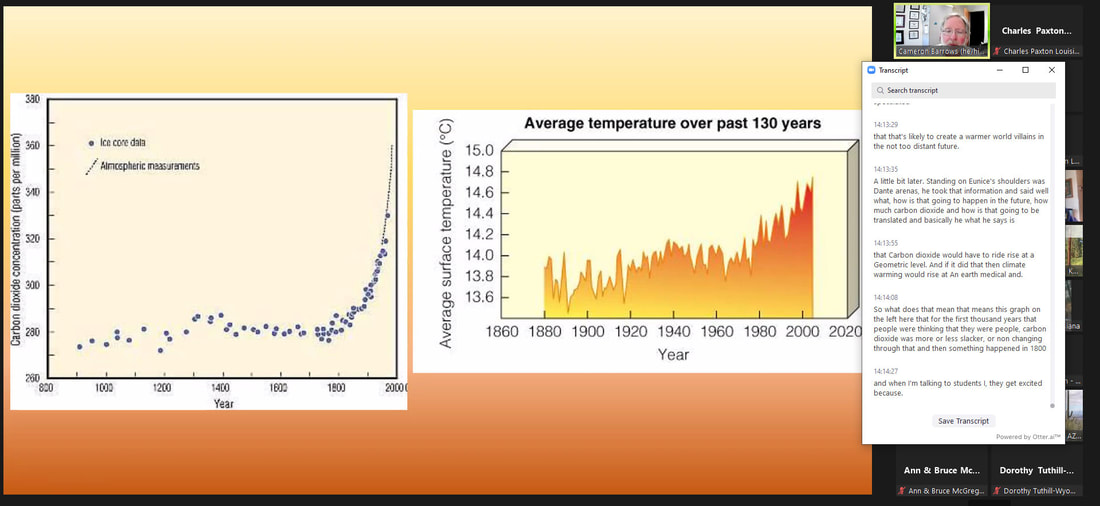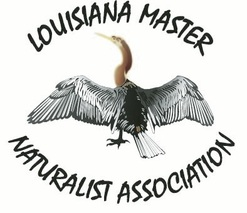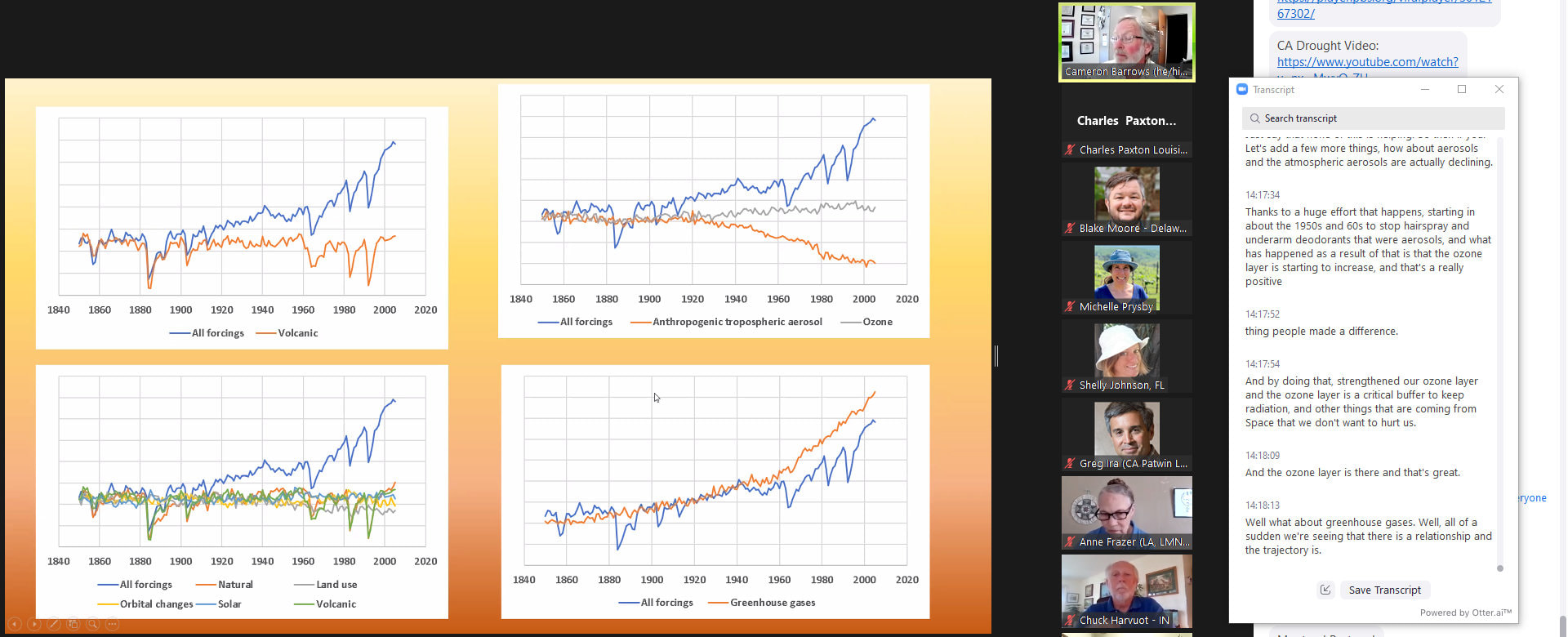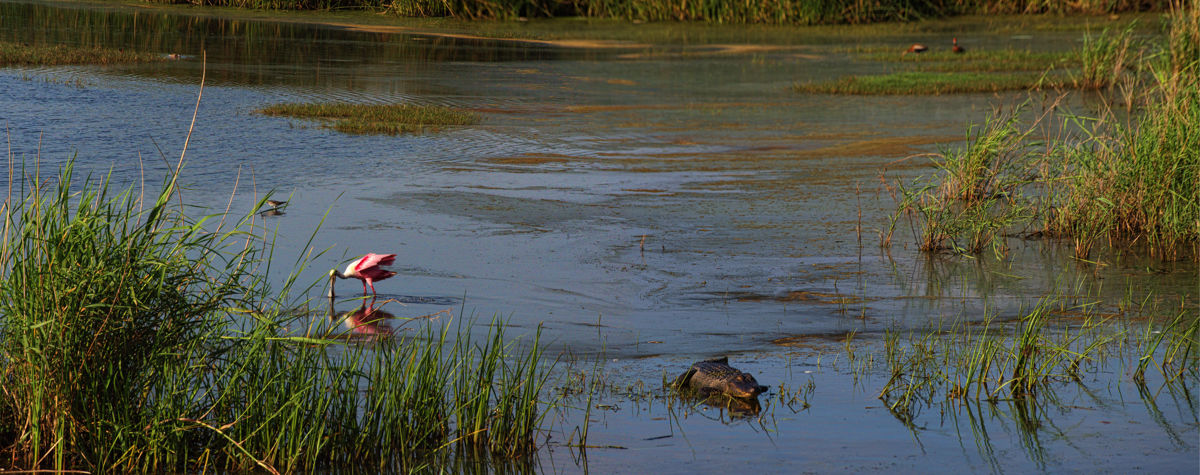Climate stewardship the role of outreach and service programsInteresting news and some links to great resources! The theme of the annual ANROSP conference in 2021 is Climate stewardship the role of outreach and service programs ANROSP is the Alliance of Natural Resource Outreach and Service Programs. Member organizations include state master naturalist programs as well as schools and cooperative extension services. In 2021 the conference was virtual and held on September 28 -30. There were four hours of programing each day with keynote presentations, workshops, breakout sessions, member produced videos on climate change and biodiversity, and more. ANROSP Conference 2021 Key Takeaways: (53 Registered participants from 22 states) LMNA members: Marty Floyd from CenLa, Anne Frazer & Charles Paxton from LMN-NE.

2. ANROSP recognizes that many of our educational institutions including UC California are founded on unceded First Nation (Native American) lands acquired through the Morrill Act of 1862. Our movement owes the First Nations a debt of gratitude and we should listen to them, serve them within our community and try to recruit them. The word master can have negative connotations in some communities. The Californians call themselves UC California Naturalist and emphasize stewardship and experience rather than expertise. Nature Stewards rather than Master Naturalists https://calnat.ucanr.edu/cs/
3. Check how your city’s climate will likely change in the future and plant some species now that can cope with current and future conditions.
4. Best Practices for Climate Change Education (Nelson, Merenlender, McCann, Ira)
https://www.business2community.com/digital-marketing/what-is-social-marketing-with-7-stellar-examples-02236451
Building good relationships is crucial. We should consider paying members of the Inclusion Committees honoraria for their work in identifying and removing perceived barriers to membership. We want local knowledge to blend with citizen science. We want Native Americans, African & Asian Americans, Chicanos and more besides to be happy and effective in our membership and board and officer roles. We can ask how should communities use us to achieve their goals? Virginia Master Naturalists are focusing on community empowerment. Michelle Prysby educated herself, got a matching grant and formed an inclusion committee with a) paid volunteer working group $200 each, b) an ad-hock feedback group and c) chapter champions. They spent physical meeting time trust building and bonding and used googledocs for sharing documents. Outcomes: a set of recommended action items at state and local levels. A large corps of interested members and thirty chapters getting involved. In Arizona, they had a great community pollinator garden project. In Texas they have a “Be The Change” campaign. 6. A lot of people are feeling sick and tired from environmental problems like climate damage and zoonotic diseases. Threats and littering contribute to mental health troubles including anxiety and depression. A lot of anxiety can stem from uncertainties. Being well-informed and actively participating in community action is helpful on multiple levels. Everyone needs to be nice to each other, be supportive, inclusive, patient and helpful. Active listening is important both in bonding and delivering relevant service. A lot of people are experiencing acute and prolonged stress from overlapping problems including climate related damages. Deprivation can be perceived as multidimensional poverty, not just a shortage of money, but often of quality time, of health, peace of mind, conveniences, good examples, and of appropriate opportunities. We need to be welcoming, attentive and accommodating and prepared to welcome a broad sampling of the demographic spectrum of the total population. Maslow’s hierarchy of needs has a bearing upon who can study and volunteer. People can’t volunteer to help their communities if they’re worried sick and preoccupied with meeting basic needs. Access to nature is important for mental and physical health, but may not be within some people’s current cultural expectations or ability to access.
We looked at models for broader demographic inclusion (California, Virginia and Texas) and were told that we should frankly appraise where we are now and where we would like to be vis a vis a valid popular mandate, better serving our mission and swelling our ranks. To do this we need to be where the target populace is, go where they are and listen to their needs and use trusted messengers to deliver our service messages within populations. Examples: a thanksgiving dinner served by rangers powerfully projected into a community. Placing a naturalist on buses to protected areas, giving information hand-outs to take-away showing people where they went, how they got there and what they did.
Notes and take-away from the Introductory Speech Greg Ira, ANROSP’s 2021 conference chair welcomed participants to their second online conference, on behalf of the University of California, agriculture and natural resources division. He noted that within last 30 years CO2 concentration rose from 355 parts per million to 414 ppm with many associated changes. He framed the context in which state master naturalist programs operate saying that during conference registration Hurricane Ida tore through Louisiana as a category four hurricane impacting members in the region again, acknowledging Marty and others, he proposed to ANROSP board that they assist in our cost of registration then IDA hit mid-Atlantic states, stalled and caused severe flooding across a wide region. That hurricane exemplified so many of the costly and catastrophic characteristics that are increasingly common, that we know are exacerbated by climate change, a warmer Gulf, causing rapid storm intensification, more extreme precipitation, bigger storm surge, a social and environmental justice dilemma, causing disproportionate impacts on the most vulnerable communities. He cited a recent Washington Post analysis of federal disaster declarations showing that nearly one in three Americans live in a county hit by a weather disaster in the past three months alone. Americans are experiencing compound catastrophes, where events overlap, for example Hurricane Ida followed by a heatwave. Such events can only increase as the frequency of billion dollar disasters themselves increase. Greg says “As naturalists we tend to focus our observations on the living world but we understand the underlying relationship between the biotic and abiotic. As climate and physical conditions and land forms change, so too will the communities and ecosystems that depend on them. Climate change is directly related to natural history, and it makes perfect sense for us to address it head on! Many of our state naturalist programs are doing just by expanding their program content to incorporate climate change education materials.” “Others are partnering with other organizations who conduct climate change education programs and still others are exploring standalone climate change education courses, as part of their core programming. This latter approach is what the UC and California naturalist program did in 2020 by launching the new Climate Stewards course, over three years in development, enabled by funding from a visionary donor, the flexibility of a team of Community educators able to shift effortlessly between bioblitzes and Community resilience assessments and the expertise of a new academic coordinator under the leadership of founding director Adina Merenlender author of “Climate stewardship taking collective action to protect California”. Author Spotlight: Adina Merenlender on Climate Stewardship as a Joyful Movement – UC Press Blog He says The national extension climate initiative took off. A climate change program team was formed in UCLA specifically designed to promote collaboration between the California climate hub system and cooperative extensions. They hope to help eliminate some of the hurdles that other States might experience. Early next year they hope to launch an opportunity for other states interested in Climate Stewards to join in a multi-state capacity building collaborative - more details to come. Greg said “In the meantime, ANROSP helps to collaborate and share the practical lessons that we've all learned as we strengthen our existing program content around climate change and embark on new initiatives. This is what ANROSP does best as a network of program managers and practitioners, we all face similar challenges associated with delivering our programs in an efficient and effective and meaningful way at the same time, each program in ANROSP is unique. ANROSP is a platform for addressing both the continuity that allows us to share ideas and aggregate results for collective impact and the site specificity that allows us to embrace the local diversity and the richness that makes every course unique we hope you find this first conference useful regardless of where you are in your state on this process of moving towards more climate change education.” Brooke Gamble, ANROSP Secretary and Community education specialist with the UC California Nachos Program made a land acknowledgement about the land they use being in northern California acknowledging that this virtual presentation is taking place through the unceded territory of the United States. She says the U.S. is home to over 600 different tribal nations in the United States, California is home to nearly 200 tribal nations, and in particular she was speaking from pomona ancestral land, in Holland about two hours north of the golden gate bridge. The California naturalists is affiliated with the UC Division of Agriculture and Natural Resources and is housed in a land grant university, one of the recipients of nearly 17 million acres of land sold through the Morrill Act of 1862 that was largely taken from tribal nations and granted to institutions. The public land grant university movement is the first major federal funding for higher education and for opening opportunities to farmers and working people previously excluded from higher education. University of California benefited and continues to benefit from the occupation and use of these lands, since the institution’s founding in 1914 so ANROSP acknowledges and honors the original inhabitants of our various regions, and encourage us to learn, which tribal nations are indigenous to the area where we're now living. For more see https://native-land.ca/ Key take-away developing Community agreements is a really powerful strategy for coalescing a group into a team. Building good relationships is crucial. Taking time to talk and listen is very important. Group norms are ways in which we behave in relationship with each other, whether that's consciously and explicitly or not. “We all come with different sets of experience and Life experiences and backgrounds, but we acknowledge each other as equals in this space we recognize each other's need to help each other become better listeners.” She recommends The National Equity project, to help transform your meetings and your workplace culture. Their mission is to transform the experiences, outcomes and life options for children and families who have been historically underserved by our institutions and systems. See The NEP Theory of Change.
0 Comments
I hope that you are all well and not too exhausted and troubled by Hurricane IDA and the aftermath.
Here is some good news that may be of interest to our members, I think. You may have heard of this initiative already but if not, I hope it will prove useful. I learned yesterday evening that the Louisiana Office of Tourism is creating a birding trail for Louisiana! They’ve provided a nomination form to fill out in order to be included on the trail. This is where they need help! The form asks for what birds you might see and what time of year you can find them. Here is the link to the nomination form: Louisiana Birding Trail Nomination Form – Louisiana Birding Trails (labirdingtrails.com) It might be possible for their staff to submit nominations on your behalf in case a naturalist can't use the form and wants to submit information some other way. You’ll see from the items below that this guide will really be a great asset to visiting nature lovers. Information needed:
If you’re interested in helping, individually or in teams and have questions then contact: Cheryl Hargrove 202-236-3777 or [email protected] The nomination form is due September 30 so the clock is ticking. |
LMNA News BlogWelcome to the Louisiana Master Naturalist Association News Blog. Archives
April 2024
Categories |
Search by typing & pressing enter

 RSS Feed
RSS Feed

